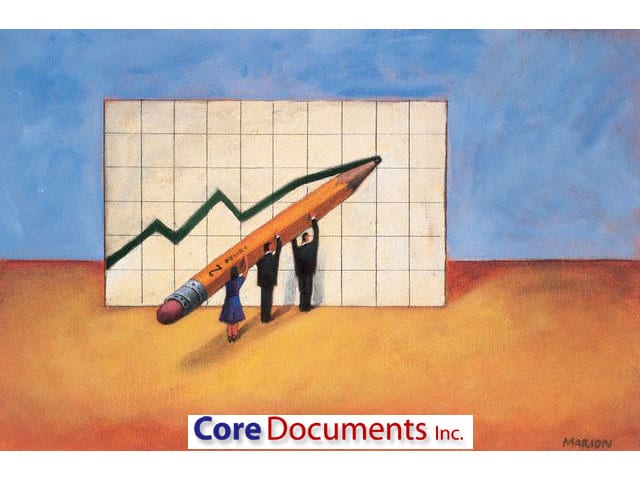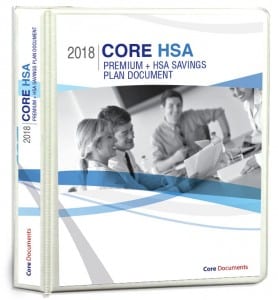Home / Blog / Section 125 Plan with HSA module: Seven reasons HSAs are taking off
Section 125 Plan with HSA module: Seven reasons HSAs are taking off
Be sure to scroll to the end of this article to learn more about Core Documents’ Section 125 Plan with HSA module!

By Kathryn Mayer –
We’ve all seen the numbers: Health Savings Accounts just keep growing.
There’s no question that HSAs are growing — but why? Experts point to a number of possible explanations.
High health care costs
Despite reports health care spending is slowing down, health costs remain incredibly high. A new report from the Kaiser Family Foundation confirms long-held suspicions that the cost of employer-sponsored health coverage continues to rise at a faster rate than wage increases and inflation.
Annual premiums for employer-sponsored family coverage climbed nearly 4 percent this year to top $16,000 for the first time, Kaiser found. The cost of single coverage rose almost 5 percent. Worker wages, meanwhile, climbed nearly 2 percent on average.
Health savings accounts are seen as a way for employers — and employees — to combat those high health costs.
“[HSAs] are becoming more popular with employers because they have a much more sustainable expense profile and help lower employee benefit costs,” says Duncan Van Dusen, CEO of Tango Health in Austin, Texas.
Plus, Van Dusen says, “as premium costs and deductibles continue to increase, more and more consumers realize they fare better with a slightly higher deductible and a much lower premium.”
Many employers offer an HSA paired with a high-deductible health plan, according to the Employee Benefit Research Institute, and it’s saving them a bundle on premiums.
EBRI analyzed detailed claims data over a five-year period from a large Midwestern employer that adopted a high-deductible health plan with a health savings account for all employees in place of its traditional health care offering.
The result? Total health care spending for the employer fell by 25 percent the first year, or $527 per person in the aggregate.
Increasing consumer involvement
One big draw of health savings accounts — and other consumer-driven health products — is they make consumers more active in their health care.
“HSAs get consumers more involved in their health care, especially if they are properly educated and use some of the newer transparency resources in the marketplace,” says Nick Severino, director of marketing for Chicago-based Flexible Benefit Service Corporation.
And more consumer involvement is good news for every party involved, insiders say.
It can save on health care woes in the long-term because CDHP customers are more likely to visit the doctor and get problems fixed before they even begin: CDHP customers sought preventive care, such as annual office visits and mammograms, more frequently than customers enrolled in a traditional plan, according to research from Cigna.
They also were more likely to participate in wellness programs and health assessments, and 59 percent more likely to access cost and procedure information to help them review potential medical costs.
And consumers involved in CDHPs and HSAs are not just engaged, they are (for the most part) satisfied — one more draw for HSAs.
New research from EBRI found satisfaction levels are rising for Americans with consumer-driven health plans, just as they are slipping for traditional health plans.
Long-term, consumer involvement might be the most important shift to health care. Bart Halling, vice president of customer solutions for UMR, the third-party unit of UnitedHealthCare, says bringing consumers to the forefront of their care is vital to making the country’s health care system work.
“Although it would be hard to make the case that consumerism in itself can be the single silver bullet to all that ails the industry, it’s easier to imagine the industry collapsing in on itself from the weight of unchecked cost trend growth, without the positive influence of consumerism,” he says.
Tax savings
Two words (or technically, a one-word hyphenate) can describe why HSAs are becoming increasingly popular: Tax-exempt.
“This is a no-brainer. HSAs, HRAs and other tax-advantaged accounts are just that: tax-advantaged,” says Jody Dietel, chief compliance officer at WageWorks Inc. and executive director of Save Flexible Spending Plans, an advocacy campaign to protect the accessibility and use of flexible spending accounts.
“Employees keep more of their money; employers keep more of their money. It’s a win-win,” she says.
“Health savings accounts provide a tremendous opportunity for American employees to take better control of their health care spending while also benefitting from the tax advantages afforded by the accounts,” adds William Applegate, vice president at Fidelity Investments in Boston. “The special tax advantages of these accounts allow employees to accumulate funds over their working life and withdraw funds tax-free for qualified medical expenses in retirement.”
Unlike with a flexible spending account, consumers don’t have to use the money by the end of the year — it can grow tax-deferred in your account for later use. There’s no deadline for making a withdrawal: Consumers can reimburse themselves in future years for medical costs incurred now.
Consumers also can use tax-free HSA money to reimburse themselves for the money that Social Security withholds from their benefits to pay for Medicare Part B, and they can use HSA funds to pay Part D or Medicare Advantage premiums, or for a portion of long-term-care insurance premiums.
Obamacare
The Patient Protection and Affordable Care Act obviously is changing all aspects of health care — and HSAs are no exception.
The law has a number of effects on HSAs. For starters, Obamacare bans the use of HSA funds for over-the-counter medications without a prescription.
But despite initial concerns over how PPACA could cripple HSAs, the law actually is spurring more interest in these types of plans, industry insiders say. PPACA naysayers suggest that health spending will increase under Obamacare. As carriers warn of rising premiums under PPACA, many industry insiders see HSAs as an affordable solution.
“If employers didn’t think they had any responsibility to provide health care, they do now,” says Dennis Triplett, CEO of UMB Healthcare Services, in Kansas City, Mo. “Now, they’re thinking ‘what are the best plans for my employees?’ And a lot of them are deciding it’s a HDHP/HSA.”
Large employers on board
Large employers are now on board with HSAs—and it’s making a huge difference in the overall numbers.
The first group that jumped on the bandwagon for HSAs were individuals, explains Triplett says.
Then smaller employers became involved, and now — finally — large employers are becoming interested in the savings accounts. And they’re making the trend really boom.
“We’re seeing a lot of growth in the large employer market, and that will be the driving segment in the next several years,” Triplett says. And large employers obviously have a very large number of employees who will then adopt the accounts.
“The larger groups are trying it and they’re seeing it works,” he says.
A recent survey from the National Business Group on Health found that the number of employers that are offering only a CDHP to employees continues to rise, with 22 percent planning to implement a total replacement CDHP next year, up from 19 percent this year.
Big savings
Most important, as far as Severino is concerned, HSAs are growing because people are seeing an impact on their bottom line.
“HSAs are becoming mainstream because the high deductible plan they’re tied to typically offer a lower insurance premium for employers, employees and consumers,” he says. “Right now, most buying decisions are based on cost, and the high-deductible plans are the common leaders for lowering costs.”
Triplett agrees.
“Of course employer savings may vary state to state, but by and large, the savings are there,” Triplett says. “The economy isn’t as vibrant as many of us would like, so a lot of us are focused on saving money and being more efficient in their operations. A lot of [employers] are looking at benefits packages and seeing that’s one area where they can save money.”
According to Towers Watson, companies in which 50 percent or more of workers have health savings accounts and other consumer-directed benefits report total costs per employee that are more than $1,000 lower than companies without these types of health plans.
The IRS Required Plan Documents are just $129
Section 125 Premium Only Plan, or a POP Plan is an essential part of any employer group health insurance and ancillary benefit program. Section 125 is the part of the Internal Revenue Code that allows employees to purchase health insurance and other ancillary benefits tax free. A Section 125 Plan legally allows your employees to pay their portion of medical insurance premium and other ancillary benefits premiums using pretax or tax-free dollars.
is an essential part of any employer group health insurance and ancillary benefit program. Section 125 is the part of the Internal Revenue Code that allows employees to purchase health insurance and other ancillary benefits tax free. A Section 125 Plan legally allows your employees to pay their portion of medical insurance premium and other ancillary benefits premiums using pretax or tax-free dollars.
By utilizing the Section 125 Premium Only Plan to pretax HSA savings the employer saves matching Social Security (FICA), as well as federal unemployment taxes (FUTA) and generally state unemployment taxes. Employer tax savings can average 7 to 10 percent more by utilizing the Section 125 Plan with the HSA module. Employees also save an additional 7.65% in FICA taxes by pretaxing HSA savings through a Section 125 Premium Only Plan. This extra savings is lost to the employer and the employee if the HSA savings is just deducted from the employees gross income on IRS Form 1040.
 Core Documents provides employers with everything they need to establish an IRS and DOL compliant Section 125 POP Plan for only $99.00 in PDF version emailed to you as soon as your document is completed. For $149, you can receive the Deluxe Binder option that includes the PDF email version ASAP, and a printed plan document in a 3-ring binder shipped via Priority Mail.
Core Documents provides employers with everything they need to establish an IRS and DOL compliant Section 125 POP Plan for only $99.00 in PDF version emailed to you as soon as your document is completed. For $149, you can receive the Deluxe Binder option that includes the PDF email version ASAP, and a printed plan document in a 3-ring binder shipped via Priority Mail.
Core Documents, Inc. has been providing free consulting, affordable plan documents, and plan updates as needed for Section 125 Cafeteria Plans and Health Reimbursement Arrangements since 1997. See more information about these fringe benefit plans at Core Documents’ website: https://www.coredocuments.com, or call toll free 1-888-755-3373.
Read more about the Section 125 Plan with HSA module from Core Documents:
Excellent small business benefit choice, HSA makes 2017 news
HSA Integral to GOP Obamacare Repeal & Replace via AHCA
HSA nondiscrimination testing vs. comparability rule depends on employer contribution method
Why should an Employer provide HSA Administration to their Employees through CoreAdmin?
HSA Administration: Debit Card Coordinates HRA/Health FSA Expense
Why Use CoreDocuments.com instead of TaxFreePremiums.com for $99 Section 125 Premium Only Plan POP Documents?
Adding the HSA Module with the Health FSA and/or HRA provides more options for tax savings
FSA, HSA, and HRA: What’s the difference?